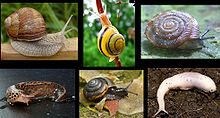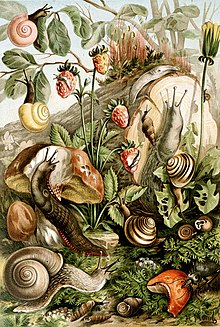Pulmonata
| Pulmonata Temporal range:
| |
|---|---|

| |
| Various examples of Pulmonata | |
| Scientific classification | |
| Domain: | Eukaryota |
| Kingdom: | Animalia |
| Phylum: | Mollusca |
| Class: | Gastropoda |
| Subclass: | Heterobranchia |
| Informal group: | Pulmonata Cuvier, 1814 |
| Taxonomic subdivisions | |
| |
Pulmonata or pulmonates is an informal group (previously an
The
Pulmonata are known from the Carboniferous period to the present.[2]
Pulmonates have a single atrium and kidney, and a concentrated symmetrical nervous system. The mantle cavity is on the right side of the body, and lacks gills, instead being converted into a vascularised lung. Most species have a shell, but no operculum, although the group does also include several shell-less slugs. Pulmonates are hermaphroditic, and some groups possess love darts.[3]
Linnean taxonomy
The taxonomy of this group according to the taxonomy of the Gastropoda (Ponder & Lindberg, 1997) was as follows:
Order Pulmonata Cuvier in Blainville, 1814 - pulmonates
- Suborder Systellommatophora Pilsbry, 1948
- Superfamily Rafinesque, 1815
- Superfamily Otinoidea H. & A. Adams, 1855
- Superfamily RathouisioideaSarasin, 1889
- Superfamily
- Suborder Basommatophora Keferstein in Bronn, 1864 - freshwater pulmonates, pond snails
- Superfamily Acroloxoidea Thiele, 1931
- Superfamily Amphiboloidea J.E. Gray, 1840
- Superfamily Chilinoidea H. & A. Adams, 1855
- Superfamily GlacidorboideaPonder, 1986
- Superfamily Rafinesque, 1815
- Superfamily Rafinesque, 1815
- Superfamily Siphonarioidea J.E. Gray, 1840
- Superfamily
- Suborder Eupulmonata Haszprunar & Huber, 1990
- Infraorder Dall, 1885 = formerly Archaeopulmonata
- Superfamily Melampoidea Stimpson, 1851
- Infraorder Trimusculiformes Minichev & Starobogatov, 1975
- Superfamily TrimusculoideaZilch, 1959
- Superfamily
- Infraorder


- Infraorder Stylommatophora A. Schmidt, 1856 - land snails
- Subinfraorder Orthurethra
- Superfamily AchatinelloideaGulick, 1873
- Superfamily CochlicopoideaPilsbry, 1900
- Superfamily PartuloideaPilsbry, 1900
- Superfamily Pupilloidea Turton, 1831
- Subinfraorder Sigmurethra
- Superfamily Acavoidea Pilsbry, 1895
- Superfamily Achatinoidea Swainson, 1840
- Superfamily AillyoideaBaker, 1960
- Superfamily Arionoidea J.E. Gray in Turnton, 1840
- Superfamily Buliminoidea Clessin, 1879
- Superfamily Camaenoidea Pilsbry, 1895
- Superfamily Clausilioidea Mörch, 1864
- Superfamily DyakioideaGude & Woodward, 1921
- Superfamily Gastrodontoidea Tryon, 1866
- Superfamily Rafinesque, 1815
- Superfamily HelixarionoideaBourguignat, 1877
- Superfamily Rafinesque, 1815
- Superfamily Oleacinoidea H. & A. Adams, 1855
- Superfamily Orthalicoidea Albers-Martens, 1860
- Superfamily Plectopylidoidea Moellendorf, 1900
- Superfamily Polygyroidea Pilsbry, 1894
- Superfamily Punctoidea Morse, 1864
- Superfamily Rhytidoidea Pilsbry, 1893
- Superfamily Sagdidoidera Pilsbry, 1895
- Superfamily Staffordioidea Thiele, 1931
- Superfamily Streptaxoidea J.E. Gray, 1806
- Superfamily Strophocheiloidea Thiele, 1926
- Superfamily TrigonochlamydoideaHese, 1882
- Superfamily Zonitoidea Mörch, 1864
- ? Superfamily AthoracophoroideaP. Fischer, 1883 = Tracheopulmonata
- ? Superfamily Succineoidea Beck, 1837 = Heterurethra
- Infraorder Stylommatophora A. Schmidt, 1856 - land snails
2005 taxonomy
The taxonomy of this group according to the taxonomy of the Gastropoda (Bouchet & Rocroi, 2005)[4] was as follows:
Informal Group Pulmonata
Contains the informal group Basommatophora and the clade Eupulmonata
Informal Group Basommatophora
Contains the clade Hygrophila
- Superfamily Amphiboloidea
- Family Amphibolidae
- Superfamily Siphonarioidea
- Family Siphonariidae
- † Family Acroreiidae
Clade Hygrophila
- Superfamily Chilinoidea
- Family Chilinidae
- Family Latiidae
- Family
- Superfamily Acroloxoidea
- Family Acroloxidae
- Superfamily Lymnaeoidea
- Family Lymnaeidae
- Superfamily Planorboidea
- Family Planorbidae
- Family Physidae
Clade Eupulmonata
Contains the clades Systellommatophora and Stylommatophora
- Superfamily Trimusculoidea
- Family Trimusculidae
- Family
- Superfamily Otinoidea
- Family Otinidae
- Family Smeagolidae
- Family
- Superfamily Ellobioidea
- Family Ellobiidae
Clade Gymnomorpha)
- Superfamily Onchidioidea
- Family Onchidiidae
- Superfamily Veronicelloidea
- Family Veronicellidae
- Family Rathouisiidae
Clade Stylommatophora
Contains the subclades Elasmognatha, Orthurethra and the informal group Sigmurethra
Subclade Elasmognatha
- Superfamily Succineoidea
- Family Succineidae
- Superfamily Athoracophoroidea
- Family Athoracophoridae
Subclade Orthurethra
- Superfamily Partuloidea
- Family Partulidae
- Family Draparnaudiidae
- Superfamily Achatinelloidea
- Family Achatinellidae
- Superfamily Cochlicopoidea
- Family Cochlicopidae
- Family Amastridae
- Superfamily Pupilloidea
- Family Pupillidae
- Family Argnidae
- Family Chondrinidae
- † Family Cylindrellinidae
- Family Lauriidae
- Family Orculidae
- Family Pleurodiscidae
- Family Pyramidulidae
- Family Spelaeodiscidae
- Family Strobilopsidae
- Family Valloniidae
- Family Vertiginidae
- Superfamily Enoidea
- Family Enidae
- Family Cerastidae
Informal Group Sigmurethra
- Superfamily Clausilioidea
- Family Clausiliidae
- † Family Anadromidae
- † Family Filholiidae
- † Family Palaeostoidae
- Superfamily Orthalicoidea
- Family Orthalicidae
- Family Cerionidae
- Family Coelociontidae
- † Family Grangerellidae
- Family Megaspiridae
- Family Placostylidae
- Family Urocoptidae
- Superfamily Achatinoidea
- Family Achatinidae
- Family Ferussaciidae
- Family Micractaeonidae
- Family Subulinidae
- Superfamily Aillyoidea
- Family Aillyidae
- Superfamily Testacelloidea
- Family Testacellidae
- Family Oleacinidae
- Family Spiraxidae
- Family
- Superfamily Papillodermatoidea
- Family Papillodermatidae
- Family
- Superfamily Streptaxoidea
- Family Streptaxidae
- Superfamily Rhytidoidea
- Family Rhytididae
- Family Chlamydephoridae
- Family Haplotrematidae
- Family Scolodontidae
- Superfamily Acavoidea
- Family Acavidae
- Family Caryodidae
- Family Dorcasiidae
- Family Macrocyclidae
- Family Megomphicidae
- Family Strophocheilidae
- Superfamily Punctoidea
- Family Punctidae
- † Family Anastomopsidae
- Family Charopidae
- Family Cystopeltidae
- Family Discidae
- Family Endodontidae
- Family Helicodiscidae
- Family Oreohelicidae
- Family Thyrophorellidae
- Superfamily Sagdoidea
- Family Sagdidae
limacoid clade
- Superfamily Staffordioidea
- Family Staffordiidae
- Superfamily Dyakioidea
- Family Dyakiidae
- Superfamily Gastrodontoidea
- Family Gastrodontidae
- Family Chronidae
- Family Euconulidae
- Family Oxychilidae
- Family Pristilomatidae
- Family Trochomorphidae
- Fossil taxa probably belonging to the Gastrodontoidea
- Subfamily † Archaeozonitinae
- Subfamily † Grandipatulinae
- Subfamily † Palaeoxestininae
- Superfamily Parmacelloidea
- Family Parmacellidae
- Family Milacidae
- Family Trigonochlamydidae
- Superfamily Zonitoidea
- Family Zonitidae
- Superfamily Helicarionoidea
- Family Helicarionidae
- Family Ariophantidae
- Family Urocyclidae
- Superfamily Limacoidea
- Family Limacidae
- Family Agriolimacidae
- Family Boettgerillidae
- Family Vitrinidae
other Sigmurethra
Two superfamilies belongs to clade Sigmurethra, but they are not in the limacoid clade.
- Superfamily Arionoidea
- Family Arionidae
- Family Anadenidae
- Family Ariolimacidae
- Family Binneyidae
- Family Oopeltidae
- Family Philomycidae
- Superfamily Helicoidea
- Family Helicidae
- Family Bradybaenidae
- Family Camaenidae
- Family Cepolidae
- Family Cochlicellidae
- Family Elonidae
- Family Epiphragmophoridae
- Family Halolimnohelicidae
- Family Helicodontidae
- Family Helminthoglyptidae
- Family Humboldtianidae
- Family Hygromiidae
- Family Monadeniidae
- Family Pleurodontidae
- Family Polygyridae
- Family Sphincterochilidae
- Family Thysanophoridae
- Family Trissexodontidae
- Family Xanthonychidae
2010 taxonomy
Jörger et al. (2010)
References
- ^ PMID 20973994.
- ISBN 80-7067-599-3.
- ISBN 0-03-056747-5.
- ISSN 0076-2997.
Further reading
- Wade, C. M.; Mordan, P. B.; Clarke, B. (2001). "A phylogeny of the land snails (Gastropoda: Pulmonata)". Proceedings of the Royal Society B: Biological Sciences. 268 (1465): 413–422. PMID 11270439.
- Holznagel, W. E.; Colgan, D. J.; Lydeard, C. (2010). "Pulmonate phylogeny based on 28S rRNA gene sequences: A framework for discussing habitat transitions and character transformation". Molecular Phylogenetics and Evolution. 57 (3): 1017–1025. PMID 20920591.
